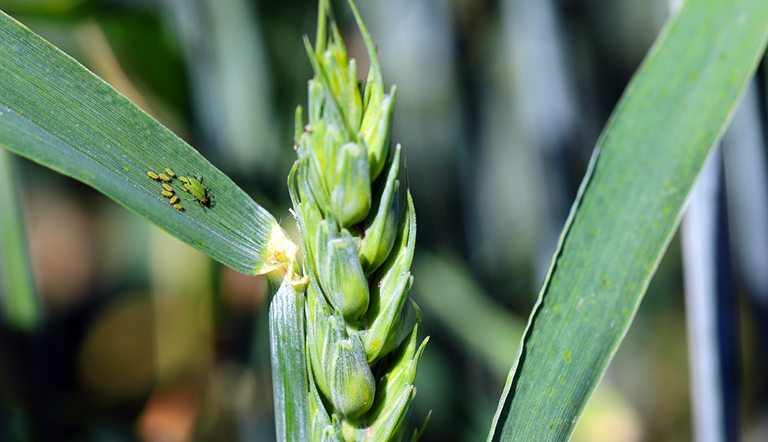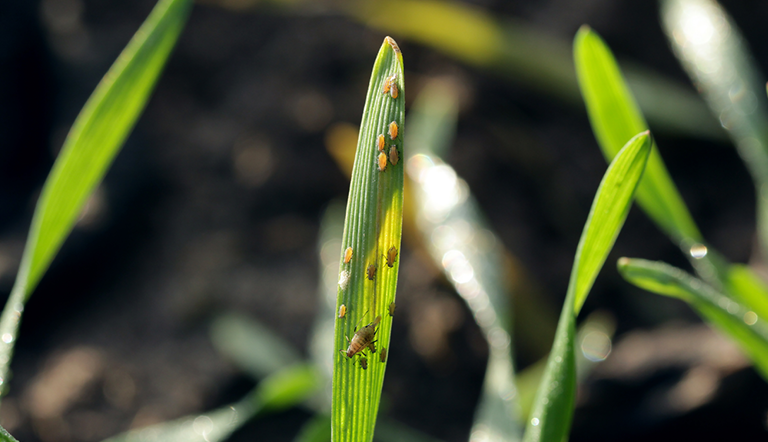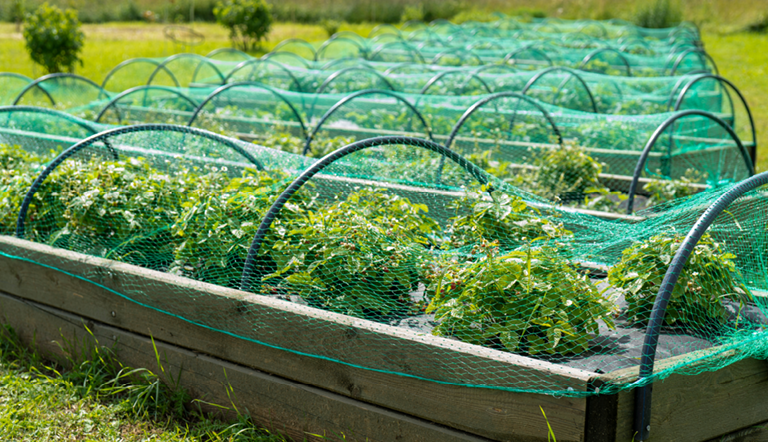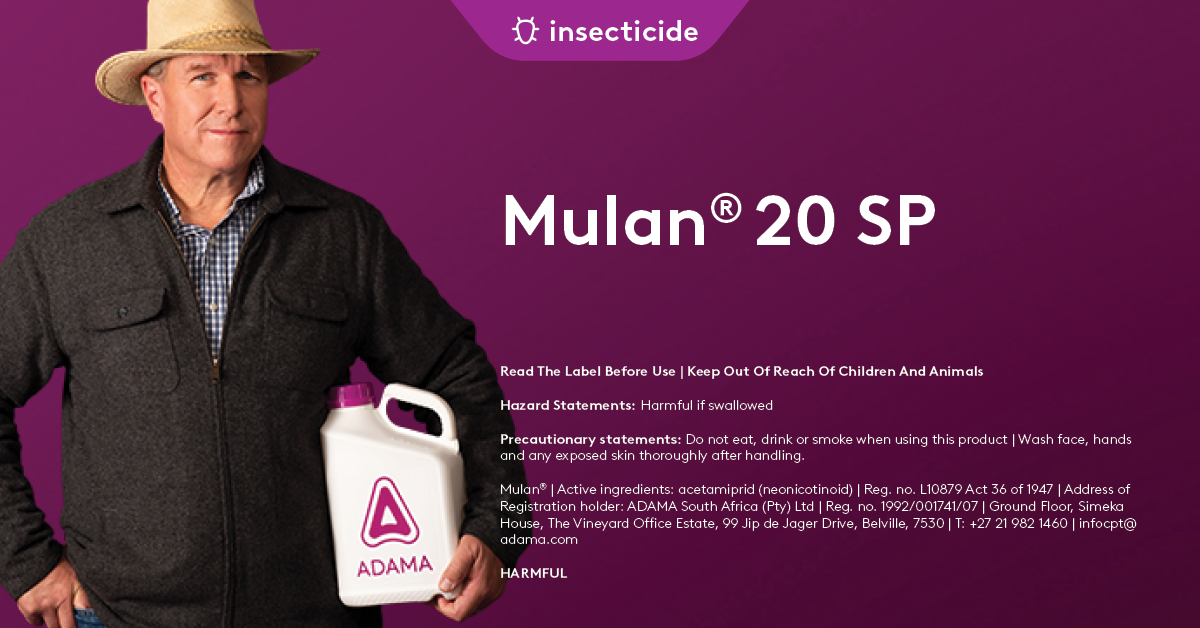
Controlling aphids in Barley

In South Africa, barley is grown predominantly in the Western Cape, followed by the Northern Cape, North West, Limpopo and Free State. After wheat, barley is one of the most important crops in the world. It is used for animal feed, to brew beer and whisky, and for human consumption.
Barley ranks fourth in the cereal food chain, coming in after maize, rice and wheat, and is vital for food security of humans and animals.
Growing barley in crop rotation is likely with wheat, canola and oats, and also with medics and lupins for animal food crops. The production of barley creates thousands of jobs in South Africa, contributing to both economic development and food security.
One of the pests affecting barley yields are aphids. These are sap sucking insects that are between 2 and 4mm in length, sometimes winged and sometimes wingless.
There are several thousand species of aphids, but in South Africa the most threatening are the Oat Aphid (Rhopalosiphum padi), the Brown Ear Aphid (Sitobion avenae) the Rose Grain Aphid (Metopolophium dirhodum) and the Russian wheat aphid (Diuraphis noxia).
Damage caused by aphids includes lowering the quality of the produce, lessening the yield of the crop, or resulting in the partial or even full decimation. Farmers and food producers need to be aware of the dangers, and should aim to prevent aphid infestations from the start.
Identifying certain aphids
The Oat Aphid
These aphids are common in the Western Cape, preferring moist or wet conditions. They are dark green with some red discolouration on the abdomen. Oat aphids are usually found on barley, or wheat, during the stooling stage, moving out once the plant is at the flowering stage.
They like to feed on the plant stems. Aphids are often seen near the soil at the beginning of an infestation, moving up the stem and towards the ear as they invade. Oat aphids spread the Barley Yellow Dwarf Virus, and they spread it quickly. The virus is highly transmissible and can result in a thirty to forty percent yield loss in the early season.
Brown Ear Aphid
These aphids are brown and green, with their most distinctive feature being the long, pitch-black cornicles at the back of the abdomen. The brown ear aphid can occur from the flag leaf stage and becomes a more serious threat after flowering as they move up in the ear to feed and multiply.
The Rose Grain Aphid
This aphid is light green and easily recognisable by a darker green stripe. It has two long cornicles which are also a light green. These aphids appear at the flag leaf stage, which is when the last leaf is unfolding. As the grain grows, the numbers may decrease. These aphids are also common in the Western Cape, enjoying the wet weather.
Russian Wheat Aphid
These are extremely damaging aphids in South Africa. Also small and green, they have two tails on the top of their abdomens. These aphids prefer hot, dry conditions and only appear when the plant, barley or wheat, is actively growing.
Symptoms of an aphid infestation
Aphids are small but are visible to the naked eye so barley food producers or farmers need to keep a watch out for these pests.
Without careful scrutiny, the symptoms of aphids may only appear once plants and their yields are already compromised. Your barley crop, be it mass produced or in your back garden, may have aphids if you see:-
- Little insects on the stems or under the leaves
- Wilting leaves on the plant.
- Loss of colour on the leaves, head of plant, or entire plant.
- Yellow plants.
- White or purple streaks on the leaves
- Heads that seem to be bleached
- Black mould that appears to be powdery.
How to manage aphids
Aphids are mobile insects that either crawl from plant to plant or fly from plant to plant or crop to crop. Pest control in barley is always better than cure. Once aphids have attacked, if a farmer does not find them in the early stages, they can literally invade.
Integrated pest management
- Keep seed beds or farming areas clear of weeds.
- Plant barley cultivators that are pest-resistant.
- Do research on companion crops. Plants like garlic or onion, with strong aromas, are thought to help.
- Look into planting detractor plants such as marigolds.
- Use specially designed insect nets.
- Introduce beneficial insects. Ladybirds love to feed on aphids as do other beneficial insects.
- Practice crop rotation.
- Diligently look after soil.
- Remove all old plants properly and carefully.
Chemical control of aphids in barley
With large crops, i.e. from large food producers, natural ways of preventing aphids may not be enough. Good crop management is critical. Farmers or food producers may want to look into alternatives, such as insecticides or herbicides. Using insecticides and herbicides that are tried and tested, and safe for the plants, environment, animals and humans, may be the best route for prevention and if need be, crop management.
ADAMA’s Mulan is a water soluble powder systemic, contact and stomach insecticide for the control of pests listed on canola, citrus, cotton, rooibos tea, table grapes, tomatoes, wheat, barley and oats. It is registered for the control of aphids in barley. The active ingredient of Mulan® 20 SP (Reg. no. L9167 Act/Wet 36 of/van 1947 N-AR 1393)
is acetamiprid (neonicotinoid). When using Mulan to control aphids in barley, it is important to ensure 60 days between the last application and harvest or feeding.
Always handle it with care and take note that it is harmful by ingestion, contact and inhalation, and must be stored in a cool, dry place, away from food and feed. Keep out of reach of children, uninformed people, and animals – it is poisonous to fish, bees and wildlife. Do not enter the treated area until the spray deposit has dried, unless wearing protective clothing.
Important to remember
With any chemical, always read the label before use. Take note of signal words and hazard statements on the labelling. ADAMA complies with the Regulations Relating to Agriculture Remedies (promulgated on 25 August 2023) under the Fertilisers, Farm Feeds, Agricultural Remedies and Stock Remedies Act, 1947 (Act 36 of 1947); and always provides the correct names of active ingredients in its products.
ADAMA South Africa (Pty) Ltd
Ground Floor, Simeka House
The Vineyard Office Estate
99 Jip de Jager Drive
Belville, 7530
infocpt@adama.com
References:
https://www.aeciph.com/news/aphids-wheat-south-africa
https://www.grainsa.co.za/how-barley-production-contributes-to-food-security
https://www.statista.com/statistics/1139298/barley-production-in-south-africa-by-province/
https://www.farmersweekly.co.za/farming-basics/how-to-crop/barley-insect-and-fungal-control-regulation-and-irrigation/
Please read the label before use.
CAUTION
-
May be harmful if swallowed.
-
May be fatal if swallowed and enters airways.
-
May cause lung damage if swallowed.
-
Causes mild skin irritation.
-
Causes serious eye irritation.
-
Repeated exposure may cause allergic disorders.
-
May cause an allergic skin reaction. Prolonged or frequently repeated skin contact may cause allergic reactions in some individuals.
-
Very toxic to aquatic life with long-lasting effects.
-
Store in a cool, well-ventilated place, away from food and feed.
-
Keep out of reach of children, uninformed persons and animals.
-
Re-entry: Do not enter the treated area until spray deposit has dried unless wearing protective clothing; preferably allow for a 24-hour re-entry period.
ADAMA South Africa (Pty) Ltd
Ground Floor, Simeka House
The Vineyard Office Estate
99 Jip de Jager Drive
Belville, 7530
infocpt@adama.com
Nimitz® (reg. no. L10436 Act/Wet 36 of/van 1947) contains fluensulfone (heterocyclic fluoroalkenyl sulfone).



